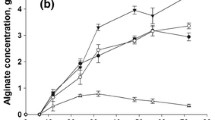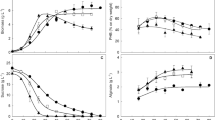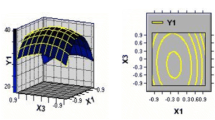Abstract
The effect of a nitrogen (N) source on growth of the N-fixing bacteria Azotobacter vinelandii was evaluated in terms of the production of alginate and its macromolecular characteristics [mean molecular weight (MMW) and viscosity] in the presence of an organic or inorganic N-source or under N-fixing conditions, in submerged shake flask cultures. The effect of the C/N ratio was also investigated in the best alginate-producing nitrogen sources. The best N-sources were peptone, tryptone, and yeast extract, yielding a maximal final alginate concentration of 4.0 ± 0.4 g/L. Under N-fixing conditions, only 1.7 ± 0.2 g/L alginate was obtained. The highest MMW was obtained in cultures grown with peptone (1,520 ± 110 kDa), and cultures grown with yeast extract, tryptone, ammonium acetate, and ammonium sulfate were not significantly different, showing values between 1,400 and 1,100 kDa. On the other hand, a lower MMW was obtained under N-fixing conditions (625 ± 110 kDa). Higher alginate productivity was obtained using a C/N ratio of 14:1 for the best inorganic N-source, but when using the best organic N-source, no significant differences were observed by increasing the amount of nitrogen at a C/N ratio of 29:1. The lower alginate production under N-fixing conditions, along with the lower MMW, led us to propose that A. vinelandii sacrifices production of the biopolymer by establishing other mechanisms that can protect the polymerase complex—findings that are consistent with the current existing literature.



Similar content being viewed by others
References
Bhattacharya SK, Dubey AK (1997) High-level expression of a heterologous gene in Escherichia coli in response to carbon-nitrogen source and C/N ratio in a batch bioreactor. Biotechnol Prog 13:151–155
Brivonese A, Sutherland WI (1989) Polymer production by a mucoid strain of Azotobacter vinelandii in batch culture. Appl Microbiol Biotechnol 30:97–102
Brownlee IA, Allen A, Pearson JP, Dettmar PW, Havler ME, Atherton MR, Onsoyen E (2005) Alginate as a source of dietary fiber. Crit Rev Food Sci Nutr 45:497–510
Castañeda M, Guzman J, Moreno S, Espín G (2000) The GacS sensor kinase regulates alginate and poly-beta-hydroxybutyrate production in Azotobacter vinelandii. J Bacteriol 182:2624–2628
Castañeda M, Sanchez J, Moreno S, Nuñez C, Espin G (2001) The global regulators GacA and sigma(S) form part of a cascade that controls alginate production in Azotobacter vinelandii. J Bacteriol 183:6787–6793
Chéze-Lange H, Beunard D, Dhulster P, Guillochon D, Cazé AM, Morcellet M, Saude N, Junter GA (2002) Production of microbial alginate in a membrane bioreactor. Enzyme Microb Technol 30:656–661
Cho K, Ryu HW, Park C, Goodrich PR (2001) Utilization of swine wastewater as a feedstock for the production of polyhydroxyalkanoates by Azotobacter vinelandii UWD. J Biosci Bioeng 91:129–133
Clementi F (1997) Alginate production by Azotobacter vinelandii. Crit Rev Biotechnol 17:327–361
Clementi F, Fantozzi P, Mancini F, Moresi M (1995) Optimal conditions for alginate production by Azotobacter vinelandii. Enzyme Microb Technol 17:983–988
Diaz-Barrera A, Peña C, Galindo E (2007) The oxygen transfer rate influences the molecular mass of the alginate produced by Azotobacter vinelandii. Appl Microbiol Biotechnol 76:903–910
Diaz-Barrera A, Silva P, Avalos R, Acevedo F (2009) Alginate molecular mass produced by Azotobacter vinelandii in response to changes of the O2 transfer rate in chemostat cultures. Biotechnol Lett 31:825–829
Gacesa P (1988) Alginates. Carbohyd Polym 8:161–182
Gacesa P (1998) Bacterial alginate biosynthesis, recent progress and future prospects. Microbiology 144:1133–1143
Galindo E, Peña C, Nuñez C, Segura D, Espin G (2007) Molecular and bioengineering strategies to improve alginate and polydydroxyalkanoate production by Azotobacter vinelandii. Microb Cell Fact 6:7
Halbleib CM, Ludden PW (2000) Regulation of biological nitrogen fixation. J Nutr 130(5):1081–1084
Miller GL (1959) Use of dinitrosalicylic acid reagent for determination of reducing sugar. Anal Chem 31:426–428
Oelze J (2000) Respiratory protection of nitrogenase in Azotobacter species: is a widely held hypothesis unequivocally supported by experimental evidence? FEMS Microbiol Rev 24(4):321–333
Oppenheim J, Marcus L (1970) Correlation of ultrastructure in Azotobacter vinelandii with nitrogen source for growth. J Bacteriol 101(1):286–291
Orr D, Zheng W, Campbell BS, McDougall BM, Seviour RJ (2009) Culture conditions affect the chemical composition of the exopolysaccharide synthesized by the fungus Aureobasidium pullulans. J Appl Microbiol 107:691–698
Page WJ, Cornish A (1993) Growth of Azotobacter vinelandii UWD in fish peptone medium and simplified extraction of poly-beta-hydroxybutyrate. Appl Environ Microbiol 59:4236–4244
Peña C, Campos N, Galindo E (1997) Changes in alginate molecular mass distributions, broth viscosity and morphology of Azotobacter vinelandii cultured in shake flasks. Appl Microbiol Biotechnol 48:510–515
Peña C, Trujillo-Roldán MA, Galindo E (2000) Influence of dissolved oxygen tension and agitation speed on alginate production and its molecular weight in cultures of Azotobacter vinelandii. Enzyme Microb Technol 27:390–398
Peña C, Hernandez L, Galindo E (2006) Manipulation of the acetylation degree of Azotobacter vinelandii alginate by supplementing the culture medium with 3-(N-morpholino)-propane-sulfonic acid. Lett Appl Microbiol 43:200–204
Peña C, Peter CP, Büchs J, Galindo E (2007) Evolution of the specific power consumption and oxygen transfer rate in alginate-producing cultures of Azotobacter vinelandii conducted in shake flasks. Biochem Eng J 36:73–80
Peña C, Millán M, Galindo E (2008) Production of alginate by Azotobacter vinelandii in a stirred fermentor simulating the evolution of power input observed in shake flasks. Process Biochem 43:775–778
Priego-Jimenéz R, Peña C, Ramírez OT, Galindo E (2005) Specific growth rate determines the molecular mass of the alginate produced by Azotobacter vinelandii. Biochem Eng J 25:187–193
Pyla R, Kim TJ, Silva JL, Jung YS (2009) Overproduction of poly-beta-hydroxybutyrate in the Azotobacter vinelandii mutant that does not express small RNA ArrF. Appl Microbiol Biotechnol 84:717–724
Rehm BH, Valla S (1997) Bacterial alginates: biosynthesis and applications. Appl Microbiol Biotechnol 48:281–288
Sabra W, Zeng AP, Lunsdorf H, Deckwer WD (2000) Effect of oxygen on formation and structure of Azotobacter vinelandii alginate and its role in protecting nitrogenase. Appl Environ Microbiol 66:4037–4044
Sabra W, Zeng AP, Deckwer WD (2001) Bacterial alginate: physiology, product quality and process aspects. Appl Microbiol Biotechnol 56:315–325
Sabry SA, Ghanem KM, Sabra WA (1996) Effect of nutrients on alginate synthesis in Azotobacter vinelandii and characterization of the produced alginate. Microbiology 12:593–598
Trujillo-Roldán MA, Peña C, Ramirez OT, Galindo E (2001) Effect of oscillating dissolved oxygen tension on the production of alginate by Azotobacter vinelandii. Biotechnol Prog 17:1042–1048
Trujillo-Roldán MA, Moreno S, Segura D, Galindo E, Espin G (2003a) Alginate production by an Azotobacter vinelandii mutant unable to produce alginate lyase. Appl Microbiol Biotechnol 60:733–737
Trujillo-Roldán MA, Peña C, Galindo E (2003b) Components in the inoculum determine the kinetics of Azotobacter vinelandii cultures and the molecular weight of its alginate. Biotechnol Lett 25:1251–1254
Trujillo-Roldán MA, Moreno S, Espin G, Galindo E (2004) The roles of oxygen and alginate-lyase in determining the molecular weight of alginate produced by Azotobacter vinelandii. Appl Microbiol Biotechnol 63:742–747
Acknowledgments
This work was partially financed by project SEP-CONACYT (82533, and 103393), PAPIIT-UNAM (IN228509) and DINAIN-Universidad Nacional de Colombia (20601005065). The authors thank Prof. Orlando Ruiz, Director of the “Laboratorio de suelos, Facultad de Ciencias Agropecuarias, Universidad Nacional de Colombia” for his technical support, Maria Fernanda Nava-Ocampo for her technical support in C/N relation replicates, and to Dr. Carlos Peña, and Prof. Dr. Enrique Galindo for their technical support. We also thank Ana Delgado for reviewing the English version of the manuscript.
Conflict of interest
The authors declare that they have no conflict of interest.
Author information
Authors and Affiliations
Corresponding author
Rights and permissions
About this article
Cite this article
Zapata-Vélez, A.M., Trujillo-Roldán, M.A. The lack of a nitrogen source and/or the C/N ratio affects the molecular weight of alginate and its productivity in submerged cultures of Azotobacter vinelandii . Ann Microbiol 60, 661–668 (2010). https://doi.org/10.1007/s13213-010-0111-7
Received:
Accepted:
Published:
Issue Date:
DOI: https://doi.org/10.1007/s13213-010-0111-7




